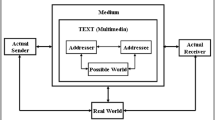Abstract
Authoring of multimedia content can be considered as composing media assets such as images, videos, text, and audio in time, space, and interaction into a coherent multimedia presentation. Personalization of such content means that it reflects the users’ or user groups’ profile information and context information. Enriching the multimedia content with semantically rich metadata allows for a better search and retrieval of the content. To actually create personalized semantically-rich multimedia content, a manual authoring of the many different documents for all the different users’ and user groups’ needs is not feasible. Rather a (semi-)automatic authoring of the content seems reasonable. We have analyzed in detail today’s approaches and systems for authoring, personalizing, and semantically enriching multimedia presentations. Based on this analysis, we derived a general creation chain for the (semi-)automatic generation of such content. In this paper, we introduce this creation chain. We present our software engineering support for the chain, the component framework SemanticMM4U. The canonical processes supported by the creation chain and SemanticMM4U framework are described in detail. We also provide an explicit mapping of SemanticMM4U framework components to the processes and argue for the benefits of defining canonical processes for creating personalized semantically rich multimedia presentations.
Similar content being viewed by others
References
Adobe, Inc., USA. Flash File Format Spec. (2007). http://www.adobe.com/licensing/developer/
Amazon, Inc., USA. amazon.com (2007). http://www.amazon.com/
Bes, F., Jourdan, M., Khantache, F.: A generic architecture for automated construction of multimedia presentations. In: Multimedia Modeling. IEEE (2001)
Boll S., Klas W.: ZYX—a Multimedia Document Model for Reuse and Adaptation. IEEE Trans. Knowl. Data Eng. 13(3), 361–382 (2001)
Boll, S., Klas, W., Westermann, U.: Multimedia document formats—sealed fate or setting out for new shores? In: IEEE International Conference on Multimedia Computing and Systems, pp. 604–610 (June 1999)
Boll, S., Sandhaus, P., Scherp, A., Westermann, U.: Semantics, content, and structure of many for the creation of personal photo albums. In: Multimedia, pp. 641–650. ACM (2007)
Bordegoni M., Faconti G., Feiner S., Maybury M.T., Rist T., Ruggieri S., Trahanias P., Wilson M.: A standard reference model for intelligent multimedia presentation systems. Comput. Stand. Interfaces 18(6–7), 477–496 (1997)
Brusilovsky P., Maybury M.T.: From adaptive hypermedia to the adaptive Web. Commun. ACM 45(5), 30–33 (2002)
Bulterman D.C.A., Hardman L.: Structured multimedia authoring. ACM TOMCCAP 1(1), 89–109 (2005)
Christodoulakis, S., Tsinaraki, C., Breiteneder, C., et al.: CoCoMA. In: Research and Advanced Technology for Digital Libraries, p. 33 (2005)
DELOS NoE. DELOS Network of Excellence on Digital Libraries (2007). http://www.delos.info/
Dey, A.K., Abowd, G.D.: Towards a Better Understanding of Context and Context-Awareness. Technical report, Georgia Institute, USA (1999)
Faconti, G.P., Rist, T. (eds.): Workshop Towards a Standard Reference Model for Intelligent Multimedia Presentation Systems (1996)
Falkovych K., Nack F.: Context aware guidance for multimedia authoring: harmonizing domain and discourse knowledge. Multimed. Syst. J. 3(11), 226–235 (2006)
Falkovych, K., Nack, F., van Ossenbruggen, J., Rutledge L.: Sample: towards a framework for system-supported multimedia authoring. In: Multimedia Modelling, p. 362. IEEE (2004)
Fink, J., Kobsa, A., Schreck, J.: Personalized hypermedia information through adaptive and adaptable system features: user modeling, privacy and security issues. In: Intelligence in Services and Networks, pp. 459–467. Springer (1997)
Geurts, J., van Ossenbruggen, J., Hardman, L.: Application-specific constraints for multimedia presentation generation. In: Multimedia Modeling, pp. 247–266. IEEE (2001)
Hjelsvold, R., Vdaygiri, S., Léauté, Y.: Web-based personalization and management of interactive video. In: World Wide Web, pp. 129–139 (2001)
IBM Corporation, USA. QBIC Home Page, (2004). http://wwwqbic.almaden.ibm.com/
Jourdan, M., Bes, F.: A new step towards multimedia documents generation. In: International Conference on Media Futures, pp. 25–28 (May 2001)
King, R., Popitsch, N., Westermann, U.: METIS: a flexible database foundation for unified media management. In: Multimedia, pp. 744–745. ACM (2004)
Kobsa, A., Koenemann, J., Pohl, W.: Personalized hypermedia presentation techniques for improving online customer relationships. In: The Knowledge Engineering Review, pp. 111–155. Cambridge University (2001)
Lemlouma, T., Layaïda, N.: Adapted Content Delivery for Different Contexts. In: Symposium on Applications and the Internet, pp. 190–197. IEEE (Jan 2003)
Lemlouma, T., Laya" N.: Context-aware adaptation for mobile devices. In: International Conference on Mobile Data Management, pp. 106–111. IEEE (2004)
Oracle Corporation, USA. interMedia, (2004). http://www.oracle.com/technology/products/intermedia/index.html
Santini S., Gupta A., Jain R.: Emergent semantics through interaction in image databases. IEEE Trans. Knowl. Data Eng. 13(3), 337–351 (2001)
Scherp, A.: A Component Framework for Personalized Multimedia Applications. OlWIR, Oldenburg, Germany, Feb. 2007. PhD Thesis. http://ansgarscherp.net/dissertation/
Scherp, A., Boll, S.: Generic support for personalized mobile multimedia tourist applications. In: Multimedia, pp. 178–179. ACM (2004)
Scherp, A., Boll, S.: Context-driven smart authoring of multimedia content with xSMART. In: Multimedia, pp. 802–803. ACM (2005)
Scherp, A., Boll, S.: MM4U—a framework for creating personalized multimedia content. In: Managing multimedia semantics, pp. 246–287. Idea group (2005)
Scherp, A., Boll, S.: Paving the last mile for multi-channel multimedia presentation generation. In: Multimedia Modeling, pp. 190–197. IEEE (2005)
Scherp, A., Boll, S., Cremer, H.: Emergent semantics in personalized multimedia content. J. Digit. Inform. Manage. 5(2) (2007)
Scherp, A., Jain, R.: Towards an ecosystem for semantics. In: Workshop on the many faces of multimedia semantics, pp. 3–12. ACM (2007)
Schilit, B., Adams, N., Want, R.: Context-aware computing applications. In: Workshop on mobil computing systems and applications, pp. 85–90. IEEE (1994)
Schmidt A., Beigl M., Gellersen H.-W.: There is more to context than location. Comput. Graph. 23(6), 893–901 (1999)
van Ossenbruggen, J., Hardman, L., Geurts J., Rutledge, L.: Towards a multimedia formatting vocabulary. In: World Wide Web, pp. 384–393 (2003)
W3C. RDF/XML Syntax Specification, Feb. (2003). http://www.w3.org/TR/rdf-syntax-grammar/
W3C. Extensible Markup Language, Feb. (2004). http://www.w3.org/TR/2004/REC-xml-20040204/
W3C. Mobile SVG Profiles, Mar. (2004). http://www.w3.org/TR/SVGMobile12/
W3C. Scalable Vector Graphics (2005). http://www.w3.org/TR/SVG12/
W3C. Synchronized Multimedia Integration Language (2005). http://www.w3.org/TR/SMIL2/
Author information
Authors and Affiliations
Corresponding author
Rights and permissions
About this article
Cite this article
Scherp, A. Canonical processes for creating personalized semantically rich multimedia presentations. Multimedia Systems 14, 415–425 (2008). https://doi.org/10.1007/s00530-008-0139-8
Published:
Issue Date:
DOI: https://doi.org/10.1007/s00530-008-0139-8




